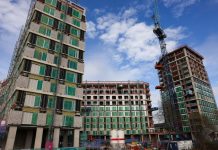Despite the fragile economic recovery and subdued consumer sentiment in many countries, global retail markets have rebounded strongly during the last year according to Cushman & Wakefield. Over four-fifths (81%) of the 63 countries surveyed by the global real estate adviser for its Main Streets Across the World report recorded prime rents increasing or remaining static over the year to June. This represents a large increase on the previous year (66%). Around one fifth of countries (19%) saw rents falling, compared with over one third (34%) in 2010.
The report provides a barometer of the global retail market, tracking rents in the top 278 shopping locations across 63 countries. It includes a ranking, produced using the most expensive location in each of the countries.
New York’s Fifth Avenue, where rents jumped by 21.6%, retained its spot as the most expensive shopping street in the world for the tenth year running. Causeway Bay in Hong Kong remained in second place and Tokyo’s Ginza in third.
The biggest climber in the top ten was Pitt Street Mall in Sydney, Australia, which jumped from ninth place to fourth following major redevelopments. Rents in the pedestrian street leapt by 33.3% year-on-year. Despite a rental increase of 4.3%, London’s New Bond Street dropped two rankings, from fourth to sixth. The UK street falls behind Avenue des Champs-Elysées in Paris which is now the most expensive retail location in Europe having registered a rental uplift of 5.3%, compared with a decrease of 9.5% last year.
Similar to last year, the Asia-Pacific and Latin America regions lead the global growth in retail rents. In Asia-Pacific, which overall saw a rental uplift of 12.2%, Wangfujing in Beijing recorded the largest growth (109.5%) and is the biggest riser globally this year. In South America, in which rents rose overall by 10.6%, Garcia D’avilla street in Rio de Janeiro was the highest climber with a rental uplift of 52.2%.
Growth across Europe (1.9%) was considerably more restrained and – with exception of the Middle-East and Africa (0%) – lagged behind other regions. However, it bounced back from the profound decline recorded last year (4.2%). Helsinki city centre showed the strongest growth in Europe, with a rental increase of 33.3%.
John Strachan, Global Head of Retail, said, “The recovery in the West is fragile but our offices have seen enhanced levels of business, particularly in the major city centres which are on the shopping lists of many international brands. Supply is short and both rents and prices are being forced upwards. Retailers continue to expand in the Middle-East and Japan, but China, India and to some extent South America remain the focus of attention for many of the world’s leading retailers.’’
Martin Mahmuti in the EMEA Research team: “The growth in global retail markets is being supported by aggressive retailer expansion in emerging markets and fierce competition for the best and most high-profile global shopping locations amongst successful brands. We do not foresee international activity slowing down; occupier demand is expected to remain robust as retailers seek to enter new prime markets abroad rather than looking for compromised locations in their own back yards. This trend will be enhanced by multi-channel retailing whereby tertiary locations will be almost entirely replaced by on-line transactions over time.”
Gene Spiegelman, Executive Vice President, New York, said, “Fifth Avenue has once again confirmed its place as the world’s most sought-after position for the foremost international retail and fashion brands. The ability for a retail brand to interact with a large, diverse and frequently changing consumer population has allowed Fifth Avenue rental values to exceed expectations. This is especially significant given the recent global economic challenges. Global retail brands have become ever more sophisticated utilizing both traditional and social media marketing channels, however, these brands still recognize the immense value created via strategically placed “brick and mortar” retailing, for which Fifth Avenue has been acknowledged as the leading global high street.”
James Hawkey, Executive Director – Retail Services, China, said, “Retailer expansion in China continues to be rapid, with the sales of China’s top 100 retailers growing at a rate of 21%. Growth in the luxury sector has been supported by strong sales. News of a potential reduction in tax on luxury goods, which would bring prices in China closer to those in Europe and America, may lead to further expansion if realised. Mid-market players such as the major international fast fashion retailers have been expanding rapidly and have achieved some early success in tier two cities. 2012 will provide an excellent environment for further rapid retail expansion in China, with high levels of new shopping centre supply in most Chinese cities.”
Jaideep Wahi, Director – Retail Services, India, commented, “Retailer expansion in India is a result of a combination of strong economic growth (7.5 %) driven primarily by internal consumption backed by quality retail supply being provided in major cities across India. Growth in the luxury sector has been a rising trend with the market growing at a rate of 13%. Both international and Indian brands regard India as an expanding luxury market which could become a significant part of their portfolio tomorrow. 2012 will provide a conducive environment for further retail expansion in India, with continued economic growth and new shopping centre supply in the top ten cities.”
Mariana Mokayad Hanania, Manager – Research Services, South America, said, “South America showed strong economic activity over the past 12 months on the back of an upturn in employment numbers, wage growth and availability of finance supporting consumer spending. These are the main drivers boosting the retail sector and rental growth. Rents in the capital of Chile were largely stable and upward movements stemmed primarily from currency fluctuations and CPI indexation with a slightly increased activity.
“In Brazil, Sao Paulo and Rio de Janeiro still dominate in terms of quality main streets and shopping centers, and are the most expensive locations and hotspots of rental growth. Although luxury brands remain concentrated in these cities, they are now considering expansion into other parts of the country, as the potential consumer spending permits. Rents in Bogota and Buenos Aires also rose, due to limited supply of prime space and extremely tight availability.”
David Woolford, Managing Director – Australia, said, “The Pitt Street Mall has undergone a substantial transformation over the last 12 months with Westfield Sydney and the MidCity centre, both of which had been under redevelopment for several years, now effectively complete. This has created a new super prime precinct characterised by larger footprint stores and an influx of high profile international brands.
“This has been confirmed with rents in the precinct consistently reaching $10,000 per sq.m, with some as high as $1,3000 per sq.m. The emergence of international brands including Zara, Bottega Veneta, Christian Louboutin and Diane von Fürstenberg has legitimised this new super prime precinct, as these retailers may have been willing to pay premium rents to secure a flagship location in the Australian marketplace.
“However, a year on year rental comparison is misleading given the fact Pitt Street Mall was largely a development site 12 months ago. Some previous retailers were forced to vacate and there were few deals elsewhere in the precinct during the construction phase. Leases that were struck were impacted by lower turnover levels and reduced pedestrian thoroughfare at the time.”
Peter Mace, Head of Central London Retail, said, “Whilst New Bond Street has dropped in the rankings, it remains one of the most sought after locations in the world for luxury brands, with demand far outstripping the supply of available accommodation. The last open market letting to take place in the prime section of the street was in December 2009 when 169 New Bond Street was let to Piaget on a new 15 year lease at a record rent. There is no question that rental levels have increased over the past twenty months but to date, a landlord has not been able to secure vacant possession of a prime shop in order to create new market evidence. I am sure it is only a matter of time before Bond Street re-establishes itself close to the top of the rankings.”
Christian Dubois, Head of Retail Services France, commented, “While austerity measures have harmed prospects for household consumption growth in France, the main thoroughfares of Paris remain attractive to international operators. The high streets market has notably benefited from an increasing number of tourists and from a resurgence in the luxury sector, as shown by several openings in the French capital and by department stores which have continued to move up-market.
“Other movements revealed a keen desire among international mass-market retailers to secure top sites and to seize the last remaining opportunities in the most established areas. The Champs-Elysées has seen several high-profile brands taking stores such as Banana Republic, Levi’s and Marks and Spencer after Tommy Hilfiger in 2010. Though rental growth on Paris’ most famous avenue has been limited so far, we expect prime rents to rise further in the short term as the shortage of space seems destined to last.”




















